Papers by MOHAMED SAAD BAJJOU
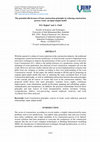
Journal of Advanced Manufacturing Systems, Feb 13, 2019
With the spread of a culture of waste reduction in the construction industry, the traditional man... more With the spread of a culture of waste reduction in the construction industry, the traditional management system has become insufficient, so it has become crucial to implement more innovative techniques to improve the performance of this sector. In response to this need, Lean Construction (LC), which is the global reference of a production system with the minimum of waste generation, has attracted several construction companies all over the world. However, previous studies indicate that are several implementation scenarios that differ from one company to another according to their own understanding of the Lean Construction concept. In this paper, the authors attempt to fill this gap by proposing an original input-output model that aims at clarifying the main conceptual basis of Lean Construction philosophy, as well as establishing interactions between the main principles of this concept and all sources of wastes that exist in the construction industry. The proposed model shows nine main principles: customer focus, supply, continuous improvement, waste elimination, people involvement, planning and scheduling, quality, standardization and transparency. In addition, the practical relationships between those principles and nine sources of waste (transportation, motion, inventory, waiting, overproduction, defects, over-processing, unused employee creativity, and work Accidents) have been analysed.
Proceedings of the 3rd International Conference on Smart City Applications
Waste occurrence has a harmful effect on the project productivity, cost, time, as well as the env... more Waste occurrence has a harmful effect on the project productivity, cost, time, as well as the environment. Until now, no survey has been conducted in Morocco to evaluate the most common causes of waste occurrence. In this work, 25 causes of wastes were identified from previous research and, then, reinforced through semi-structured interviews with Moroccan construction experts. Thereafter, a questionnaire survey was employed to assess the significant causes of wastes based on the perception of Moroccan construction practitioners. The findings of this study revealed that the five most recurrent wastes' causes are 1- late payment, 2- lack of training for employees, 3- lack of waste management strategy, 4- inefficient planning and scheduling, and 5- lack of collective planning.

International Journal of Automotive and Mechanical Engineering
Although lean manufacturing emerged in the 1990s, and since then, it has become known and recogni... more Although lean manufacturing emerged in the 1990s, and since then, it has become known and recognised worldwide, companies still struggle to implement it successfully, especially in less developed countries. The purpose of this paper is to assess the level of maturity of lean production within small and medium-sized companies, identify what the benefits of lean implementation are, and present an exploration and analysis of the barriers that influence the implementation of lean production in these companies.To achieve this objective, items from previous studies were extracted through a systematic literature review and then validated by interviews with Moroccan experts in the manufacturing and non-manufacturing industry; on the other hand, a questionnaire survey was conducted with 78 small and medium enterprises in Morocco. Subsequently, all collected responses were statistically analysed using Statistical Package for Social Sciences (SPSS V21.0). The results show that the lean approac...

Proceedings of the 3rd International Conference on Smart City Applications, 2018
The performance of construction projects worldwide is significantly impacted by the occurrence of... more The performance of construction projects worldwide is significantly impacted by the occurrence of waste; however, few studies have been carried out in this research area especially in developing countries. In this study, 24 types of waste have been identified starting from a review of previous research, and then reinforced by semi-structured interviews with Moroccan construction experts. Thereafter, a structured questionnaire was conducted to survey 330 Moroccan construction practitioners with a view to investigate the critical origins of waste in Morocco. "Activity start delays" was found to be the most significant source of waste according to the perceptions of the surveyed respondents. Furthermore, the statistical analysis revealed that the top three ranked waste categories were: 1-unused employee creativity, 2-delay and waiting, and 3-defects/errors/corrections.

Proceedings of the Institution of Mechanical Engineers, Part B: Journal of Engineering Manufacture, 2021
The spread of additive manufacturing in recent years has broadened the sector of applications, na... more The spread of additive manufacturing in recent years has broadened the sector of applications, namely in the construction field. This technology enables new functionalities and opportunities to be considered for the construction industry. Indeed, 3D printing processes can directly or indirectly affect the concrete material. Besides the printing processes for concrete structures, there are other indirect uses of 3D concrete printing, such as the manufacture of molds and formwork. However, its integration raises new challenges. This paper is first devoted to the state-of-the-art regarding the use of additive manufacturing in construction through a bibliographical study and an overview of various experiences in different countries. Secondly, the opportunities of such technologies for the construction sector will be discussed. Then, the issues and challenges related to the applicability and integration of concrete additive manufacturing will be highlighted. Finally, a diagnosis of the a...

Engineering, Construction and Architectural Management, 2021
PurposeWaste is typically encountered during the building's life cycle, from the design phase... more PurposeWaste is typically encountered during the building's life cycle, from the design phase, through the construction phase, to modification and demolition. Most of these construction wastes are unnoticed or unattended by project managers, which lead to serious environmental problems. Effective waste reduction strategies will require a thorough and detailed understanding of the causes of construction waste. Hence, this paper aims to explore critical waste factors (CWFs) affecting the performance of construction projects.Design/methodology/approachAn extensive literature review was carried out to determine these factors based on previous studies, from which a questionnaire was developed. Series of statistical analyses such as reliability analysis, Spearman Correlation, Kruskal–Wallis and factor analysis were performed on a total of 330 valid responses to identify latent factors responsible for wastes occurrence.FindingsThis study reveals 31 CWFs through evaluation of prior rele...

International Journal of Engineering Research in Africa, 2021
Construction waste is a serious challenge that requires particular attention from construction ma... more Construction waste is a serious challenge that requires particular attention from construction managers to improve the performance of their projects and survive in a highly competitive market. Simulation modeling provides decision-makers with a controllable operating system and a more cost-effective environment which allows a better understanding of construction processes deficiencies. The current paper aims to assess waste in a bricklaying process using ARENA. Data used for simulation modelling were collected through field observations and video recording techniques. Using EasyFit, goodness-of-fit tests were performed to identify the best probabilistic density functions for each construction operation in the studied process. Simulation outputs show that non-value-added (NVA) activities dominate the bricklaying process with 85.2 % of the total cycle time. These results indicate a strong potential for optimizing the process under study by reducing these sources of waste especially re...

Innovations in Smart Cities Applications Edition 2, 2019
Construction projects worldwide are significantly affected by waste occurrences which negatively ... more Construction projects worldwide are significantly affected by waste occurrences which negatively influence their performance. Nevertheless, limited studies have been performed aiming at waste assessment, especially in developing countries. In the current study, 24 sources of wastes were identified through a review of previous works, consolidated by interviews with Moroccan construction experts. Subsequently, a structured questionnaire was used to survey 330 Moroccan construction professionals to explore the critical sources of wastes in Morocco. “Activity start delays” was found to be the most significant source of waste according to the perceptions of the surveyed respondents. Furthermore, the statistical analysis revealed that the top three ranked waste categories were: 1—unused employee creativity, 2—delay and waiting, and 3—defects/errors/corrections. These findings are expected to help practitioners and managers of construction projects to focus their resources and interest on the main sources of wastes and to establish, therefore, more effective strategies for waste reduction.

2018 4th International Conference on Optimization and Applications (ICOA), 2018
Traditional construction management techniques are criticized by its inability to deliver constru... more Traditional construction management techniques are criticized by its inability to deliver construction projects on time, with the quality requested by the customer, and without cost overrun. It has become crucial for Moroccan construction practitioners to seek creative approach and to look for new ways of thinking in order to resist to the increasing competition and to survive with market constraints, especially when compared to the significant improvements achieved in the Moroccan manufacturing industry. Lean Construction (LC) is a very effective approach to design production systems for the purpose of reducing waste of time, of materials, and effort as well as generating the maximum possible amount of value. Lean construction has been introduced into the Moroccan construction industry; however, it is still in its infancy. Based on a structured questionnaire survey, this article aims to evaluate the perceptions of the Moroccan construction professionals on the Lean Construction implementation in the Moroccan construction industry. To achieve this objective, a total of 330 responses were collected and then analyzed using Statistical Package for Social Sciences (SPSS V20.0 for Windows). The following conclusions were made, more than half of the respondents (172 professional; 52.1%) think that Lean Construction approach is adapted to any size of Moroccan companies; the respondents agreed that Lean Construction implementation would add positive impacts to the Moroccan construction projects (with an overall mean value of 3.84); LC is a high priority for the Moroccan construction projects (with an overall mean value of 3.84).

Innovations in Smart Cities Applications Edition 2, 2019
Waste generation has negative impact on the environment, productivity, budget, and project comple... more Waste generation has negative impact on the environment, productivity, budget, and project completion schedule. Nevertheless, no study has been carried out in Morocco aiming at assessing the common causes of waste generation. In the current study, 25 causes of wastes were extracted from previous studies and, then, validated through semi-structured interviews with Moroccan construction experts. Subsequently, a questionnaire method was used to survey 330 Moroccan construction practitioners. The frequency method was employed to measure the level of occurrence of each item. Statistical Analysis of the collected data indicated that the five most recurrent causes of wastes are: 1- late payment, 2- lack of training for employees, 3- lack of waste management strategy, 4- inefficient planning and scheduling, and 5- lack of collective planning. These findings enable academics and engineering managers to benefit from increased awareness regarding the most common causes of wastes and, hence, de...

Journal of Engineering, Design and Technology, 2018
Lean construction provides innovative practices to manage construction projects while reducing wa... more Lean construction provides innovative practices to manage construction projects while reducing waste and improving performance. This paper aims to explore the current level of awareness of lean construction practices among Moroccan construction professionals to assess the potential benefits derived from lean construction practices and to identify the critical barriers hindering a successful implementation.,The paper opted for a quantitative approach by using a structured questionnaire survey. A total of 330 valid responses were collected from Moroccan construction practitioners involved in private and public construction organisations.,The results show that 61 per cent of the respondents are familiar with lean construction practices. The findings have also pointed out that the lean construction approach adds a positive impact, specifically on quality, safety and environmental level. In addition, the main barriers hindering a successful lean construction deployment in Morocco are lac...
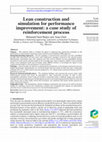
International Journal of Productivity and Performance Management, 2020
PurposeThis research seeks to evaluate the impact of applying lean construction principles on the... more PurposeThis research seeks to evaluate the impact of applying lean construction principles on the performance of reinforcement operations using a discrete-event simulation (DES) approach.Design/methodology/approachProcess mapping of reinforcements operations was first established through field observation and interviews with construction managers involved in the selected project. Subsequently, quantitative data were gathered and then used to identify the best probabilistic density functions for each activity duration based on the fit-quality tests. Upon testing the validity of the real-world model, a lean simulation model was developed, using ARENA software, to investigate the impact of lean construction principles on the performance of such processes.FindingsLean principles are effective in enhancing the performance of the selected construction process. Output performance measurements for real-world model and lean model revealed that lean construction principles led to 41% improvem...
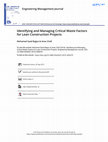
Engineering Management Journal, 2019
This study highlights the findings of an empirical study to investigate critical waste factors (C... more This study highlights the findings of an empirical study to investigate critical waste factors (CWFs) affecting the performance of construction projects. Twenty-four CWFs were identified through an extensive literature review and consolidated by semistructured interviews with construction experts. A structured questionnaire was designed and completed by 330 participants from public and private projects in Morocco. The statistical analysis indicated that the top five ranked factors are Activity Start Delays, Rework, Unused Employee Creativity, Long Approval Process, and Waiting Due to Work Not Completed by Others. Factor analysis was conducted and indicates the underlying factors for the 24 CWFs are inefficient site management, improper planning and poor communication, rework and poor quality, and human-related factors. The findings of this study provide guidance to practicing engineering managers to develop appropriate strategies to effectively manage CWFs for lean construction projects through waste reduction.

AIP Conference Proceedings, 2018
With the rising attention on the topic of Lean construction and its benefits, more and more compa... more With the rising attention on the topic of Lean construction and its benefits, more and more companies aim to implement the Lean philosophy in their culture. Together with changing the companies' culture multiple challenges occur. Hence, it is of utmost importance to identify factors, which lead to poor management in Lean construction activities. Therefore, this paper intends to identify and categorize barriers leading to poor implementation of the Lean philosophy. In this respect, a set of barrier groups comprising a total of twenty-seven components were identified. A questionnaire was designed and administered to Lean construction professionals in order to rank the importance level of the selected barriers. The paper proposes that lack of 'top management support', 'misperception about Lean practices', 'lack of information sharing and integrated change control' are the top three barriers for Lean implementation. The findings of the study indicate that Lean implementation might be conducted with higher efficiency and productivity by removing the barriers for implementation. This study might guide Lean professionals to align their strategies with Lean practices by knowing and recognizing the main barriers.
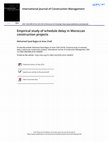
International Journal of Construction Management, 2018
As a chronic and a common problem worldwide, most construction projects suffer from schedule dela... more As a chronic and a common problem worldwide, most construction projects suffer from schedule delay and construction projects in Morocco are not an exception. The aim of this study is to determine the critical causes affecting projects delays in Moroccan construction industry. Fortynine causes of delay were identified from the literature review and redefined through interviews with Moroccan experts. These causes are classified according to nine categories: client, contractor, consultant/designer, finance, planning and scheduling, communication and contractual relationship, material, labours and equipment, and external. A questionnaire survey was conducted with public and private contractors and consultants in order to assess the relative importance of construction delay causes in Morocco. A total of 330 valid responses were collected. Statistical analysis of data collected from this survey study reveals that the top-10 delay causes are: delay of progress payment, lack of training for employees, lack of waste management strategy, unrealistic contract duration imposed by clients, rework due to the construction errors, excessive subcontracting, delay in obtaining permits from governmental agencies, ineffective planning and scheduling, lack of collective planning, and unskilled workforce. These findings can be helpful for construction project managers to guide efforts in improving the performance of the Moroccan construction industry.

International Journal of Engineering Research in Africa, 2017
The development of more effective management techniques has become essential for the improvement ... more The development of more effective management techniques has become essential for the improvement of working conditions within the company. The construction industry is characterized by unpredictable and fluctuating construction processes which increase the level of risk of accidents. In this context, this work aims at conducting a synthesis of the most reliable research in the field of safety management in order to study the contribution of Lean Construction practices in the promotion of safety. The study evaluates the potential effectiveness of Lean Construction tools such as (Last Planner System, Visual Management, 5S, Error-proofing) in promoting the safety on construction sites. This study shows that lean construction tools have a great potential to improve the safety performance. Several Lean Construction practices such as the correlation between scheduled tasks and the ability of the staff working on site, choosing of working methods in compliance with safety requirements, the...

Journal of Advanced Manufacturing Systems, 2018
In the new global economy, Lean Construction has become an effective way to design construction s... more In the new global economy, Lean Construction has become an effective way to design construction systems, which aims at reducing all forms of waste and creating the maximum of value for the customer. However, previous studies have reported that there are various implementation approaches, and most construction practitioners have applied this management philosophy according to their own understanding of Lean Construction principles. The main aim of this study is to develop a conceptual model for a successful deployment of lean construction. In this paper, an original generic model has been proposed based on a rigorous analysis of six relevant Lean Construction models that have been designed, validated, and tested in several countries (USA, UK, Malaysia, Germany, and Brazil). The findings of this work show that there are nine main Lean Construction principles and which are: customer focus, supply, continuous improvement, waste elimination, people involvement, planning and scheduling, q...

International Journal of Engineering Research in Africa, 2017
The growing context of globalization permanently increases pressure on the construction companies... more The growing context of globalization permanently increases pressure on the construction companies to improve their performances in order to resist to the constraints of competitiveness in the international market. It has become ineluctable to look for introducing a new alternative capable of bringing creative improvement to the traditional production system. This paper will relate mainly to the most relevant management techniques in the construction industry, and more specifically, the lean construction concept. Initially, we will determine the main characteristics of the construction industry compared to the manufacturing industry according to three levels: on-site production, one of a kind projects, and complexity. Subsequently, we will focus our attention on the main sources of waste in the construction industry. Finally, a rigorous comparative study will be carried out to show the contribution of the lean construction tools in the promotion of traditional construction especially...
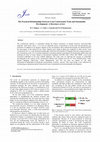
JOURNAL OF ENGINEERING SCIENCE AND TECHNOLOGY REVIEW, 2017
The construction industry is considered among the largest consumers of natural resources (non-ren... more The construction industry is considered among the largest consumers of natural resources (non-renewable materials, fossil fuels, water...). It is also an important source of generation of solid waste and greenhouse gas emissions. In addition to its negative impacts on the environment, most construction projects are characterized by the non-respect of the triptych (Cost, Time, Quality) and a high accident rate compared to other sectors. Lean construction (LC) is a new production philosophy which has the potential of bringing innovative improvements in the construction sector. It is a systemic approach to meeting customer expectations by maximizing added value and reducing all forms of waste. Based on international standards (AFNOR, GRI, UNEP, ISO 26000...) and recent researches published in the most reliable databases, this study aims at exploring the concept of sustainable development in the context of the construction industry and examines how the LC tools (Prefabrication, Value Stream Mapping, Poka-Yoke, visual Management, and 5S) can have an impact on the three dimensions of sustainable development (environment, economy, society). This work brings a new reflection by constructing an interaction matrix between the Lean Construction tools and sustainable development.

Journal of engineering manufacture, 2021
The spread of additive manufacturing in recent years has broadened the sector of applications, na... more The spread of additive manufacturing in recent years has broadened the sector of applications, namely in the construction field. This technology enables new functionalities and opportunities to be considered for the construction industry. Indeed, 3D printing processes can directly or indirectly affect the concrete material. Besides the printing processes for concrete structures, there are other indirect uses of 3D concrete printing, such as the manufacture of molds and form-work. However, its integration raises new challenges. This paper is first devoted to the state-of-the-art regarding the use of additive manufacturing in construction through a bibliographical study and an overview of various experiences in different countries. Secondly, the opportunities of such technologies for the construction sector will be discussed. Then, the issues and challenges related to the applicability and integration of concrete additive manufacturing will be highlighted. Finally, a diagnosis of the applicability and integration of concrete additive manufacturing has been made by analyzing the results of a survey of Moroccan professionals. The objective is to raise and identify key factors for successful integration.





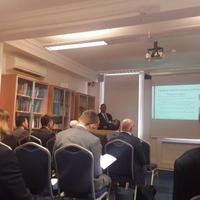



Uploads
Papers by MOHAMED SAAD BAJJOU